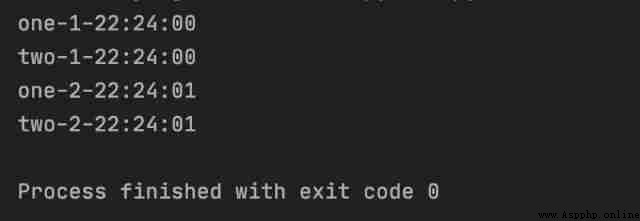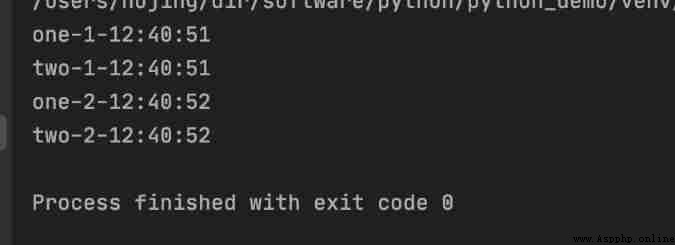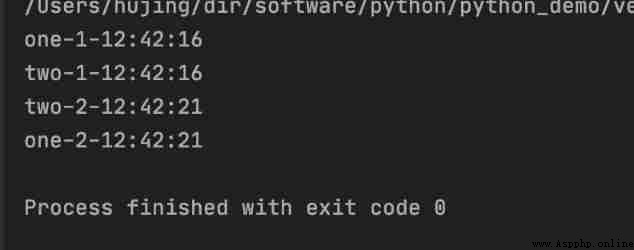I've been reading some recently Python Source code , Found out async This keyword . I checked and found Python Association in .
Xie Cheng , stay GO I used it in , In short , It is a lightweight thread , By the language itself to achieve the scheduling of different processes . Thinking about Python It may be the same thing in . But I Google Search the , The previous descriptions give the following examples :
def consumer():
r = ''
while True:
n = yield r
if not n:
return
print('[CONSUMER] Consuming %s...' % n)
r = '200 OK'
def produce(c):
c.send(None)
n = 0
while n < 5:
n = n + 1
print('[PRODUCER] Producing %s...' % n)
r = c.send(n)
print('[PRODUCER] Consumer return: %s' % r)
c.close()
c = consumer()
produce(c)
This is this. , Is this Xiecheng ? This is just a generator ?
But think about the features of the generator :
It can save the running state and restore it in the next execution , It seems no problem to say that he is Xie Cheng . and , Python The coroutines in run in the same thread , That is, serially executed , So there is no need to lock it .
Look at the generator above , Is there an idea ? This thing is just a generator ? Why is it called Xiecheng ? you 're right , It's the generator .
It says so , Characteristics of the process , You can stop the execution of the current function and save the current state , And restore at the next execution . For a single threaded run , When do I need this operation ? Waiting time . For example, wait for the file to open , Waiting for lock , Wait for the network to return, etc . There is nothing to do when the program is running , You can do other things first , When this side is ready, we will continue to come back to carry out . The following is a simple sleep give an example .
How we use native yield Generator to implement a task queue ? I wrote casually :
import time
def yield_sleep(delay):
start_time = time.time()
while True:
if time.time() - start_time < delay:
yield
else:
break
def hello(name):
print(f"{
name}-1-{
time.strftime('%X')}")
yield from yield_sleep(1)
print(f"{
name}-2-{
time.strftime('%X')}")
# Create tasks
tasks = [hello('one'), hello('two')]
while True:
if len(tasks) <= 0:
break
# Copy the array , You can traverse normally when deleting below
copy_tasks = tasks[:]
for task in copy_tasks:
try:
next(task)
except StopIteration:
# Iteration complete , Remove elements
tasks.remove(task)

A brief explanation , We call each task yield On temporary return , Carry out task rotation . such , Originally needed 2s Actions performed , All we need is 1s that will do . ( To illustrate the effect , Just a simple implementation . )
Ah , In this way , All support yield Generator language , In fact, they all support coroutine Yeah , For example, I'm older PHP, Hey .
stay Python 3.4 in , Introduced asyncio package . Will be asynchronous IO The operations are encapsulated .
In short , asyncio Inside , A task queue is maintained , When the function executes yield When the executive power is transferred , Switch to the next task to continue . Um. , That's about it .
import asyncio
import time
@asyncio.coroutine
def hello(name):
print(f"{
name}-1-{
time.strftime('%X')}")
yield from asyncio.sleep(1)
print(f"{
name}-2-{
time.strftime('%X')}")
# Get event queue
loop = asyncio.get_event_loop()
# Concurrent execution of tasks
tasks = [hello('one'), hello('two')]
loop.run_until_complete(asyncio.wait(tasks))
loop.close()

You can see , The function is first executed to yield when , Made a break and gave up the right to execute .
asyncio.get_event_loop() Method , Generate an event queue loop.run_until_complete Method to run the specified task queue asyncio.sleep Function and the one we implemented above yield_sleep It's the same effect . stay yield When interrupted , Another task will be found in the queue and executed One thing to pay attention to , Python It is necessary to hand over the right to execute the coordination process . With this Go Different . in other words , The timing of CO process switching is :
for instance ( Simply modify the above example ):
import asyncio
import time
@asyncio.coroutine
def hello(name, delay, not_yield):
print(f"{
name}-1-{
time.strftime('%X')}")
# Occupy the coordination process and wait
if not_yield:
time.sleep(delay)
else:
yield from asyncio.sleep(1)
print(f"{
name}-2-{
time.strftime('%X')}")
# Get event queue
loop = asyncio.get_event_loop()
# Concurrent execution of tasks
tasks = [hello('one', 2, False), hello('two', 5, True)]
loop.run_until_complete(asyncio.wait(tasks))
loop.close()

You can see , Although the coordination process 1 Just want to wait 1s, But because of the synergy 2 He has been occupying the executive power without releasing it , So synergetic process 1 Wait until the process 2 Only after the execution is completed can the right of execution be obtained again , Both 5s after
stay Python 3.5 in , Added async/await Grammatical sugar .
Simply speaking , The above @asyncio.coroutine Switch to async, take yield from Switch to await That's it . The other is constant . After replacement , The code above becomes like this , It means the same .
import asyncio
import time
async def hello(name):
print(f"{
name}-1-{
time.strftime('%X')}")
await asyncio.sleep(1)
print(f"{
name}-2-{
time.strftime('%X')}")
# Get event queue
loop = asyncio.get_event_loop()
# Concurrent execution of tasks
tasks = [hello('one'), hello('two')]
loop.run_until_complete(asyncio.wait(tasks))
loop.close()
The way mentioned above is to briefly introduce the implementation , Assist in Python The more common ways of using in :
import asyncio
import time
async def hello(name):
print(f"{
name}-1-{
time.strftime('%X')}")
await asyncio.sleep(1)
print(f"{
name}-2-{
time.strftime('%X')}")
async def main():
""" Create a task and execute """
# programme 1: Add and execute tasks
task1 = asyncio.create_task(hello('one'))
task2 = asyncio.create_task(hello('tow'))
# call `asyncio.create_task` After method call , The task already exists in the scheduling queue
# Even without manual `await` wait for , It will also be executed during CO process switching . We add `await` Just waiting for all the tasks to be completed
await task1
await task2
# Wait for the execution of all the cooperation processes , Separate from await identical
await asyncio.wait({
task1, task2})
# Wait for the cooperation process to execute . If the execution is not completed after the specified time , An exception will be thrown
await asyncio.wait_for(task1, 1)
# programme 2: Execute the cooperation process in batch . programme 1 A simplified version of the
# The return value is the set of all coroutines
await asyncio.gather(
hello('one'),
hello('tow')
)
""" Get task information """
# Get the currently executing task
current_task = asyncio.current_task()
# Get all outstanding tasks in the event loop
all_task = asyncio.all_tasks()
# Close a collaboration , No more execution
task1.cancel()
# Get the result of the task . If the process is closed , It throws an exception
ret = task1.result()
asyncio.run(main())
Create and execute a collaboration task , So you don't have to worry about the event queue , We are main All you have to do in the function is create a task and execute .
Be careful , Use keywords async Method of definition , It's a partner , Cannot simply call hello('1234'), Its implementation is a decorator , Back to a coroutine object .
about Python Association in , That's about it . In short , Is to carry out IO Time consuming operations , Temporarily cede the right of execution , With better execution efficiency of activities .
But the problem is , For this time-consuming operation , We can't do it all by ourselves every time . Don't panic , In fact, many asynchronous operations , Have been implemented , concrete : https://github.com/aio-libs, List most of the libraries that have implemented asynchronous operations . Yes, of course , System asyncio There are also some simple asynchronous operation implementations in the library .
When writing time-consuming operations later , You can use the cooperative process , Like crawlers. . When a crawler makes a request , It needs to wait for return , At the same time n A request , Can greatly improve the efficiency of the reptile .